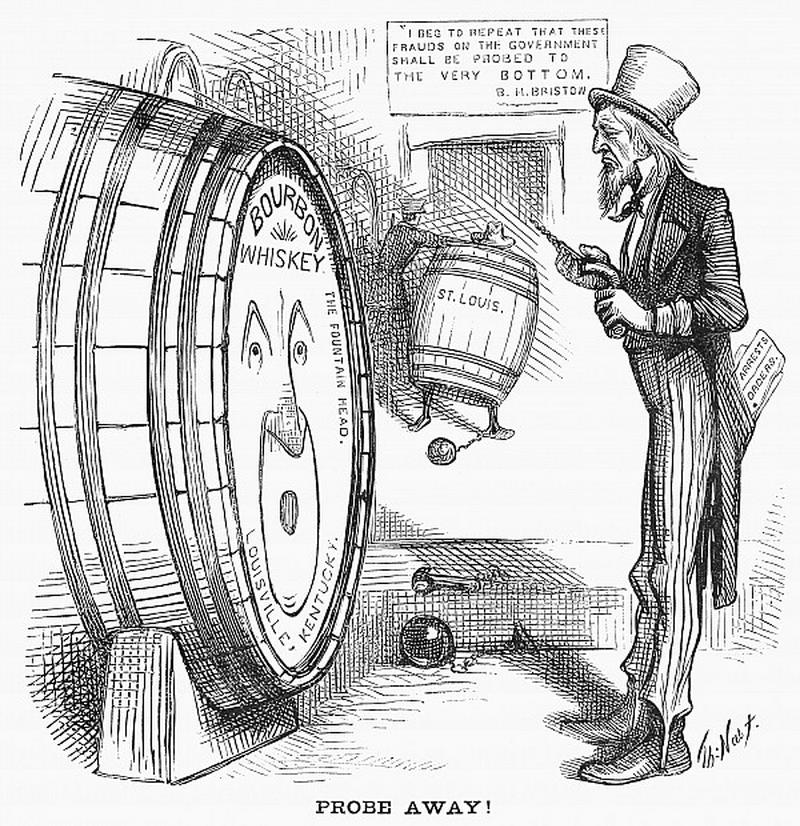The Whiskey Ring: The First Time Abraham Lincoln's Republican Party Lost Credibility
By | January 8, 2021

We think of the splintering of American political parties and government corruption as a modern symptom of democracy, but even as the United States was trying to pull itself together and rise from the ashes of the Civil War, government officials were on the take. During the Reconstruction Era, a plot called the Whiskey Ring didn't just siphon off millions of dollars from the United States in tax money, it further increased distrust of politicians, specifically the Republican Party, and became the first real American scandal.
Whiskey Taxes And You
Much of the Civil War was funded through the Revenue Act of 1862, a bill that established the office of the Commissioner of Internal Revenue and created the income tax and an excise tax on luxury items, including liquor, tobacco, playing cards, gunpowder, feathers, etc. Unsurprisingly, most of the money made from taxes came from the sales of tobacco and liquor.
Taxes on whiskey increased from 20 cents to $2 per gallon after the Civil War, which led to rampant moonshining. The government tried to crack down on moonshiners by lowering the tax to 70 cents per gallon by early Reconstruction, but no matter low it was, people didn't want to pay the full amount. In order to keep the whiskey flowing and line their pockets, members of the new tax bureau figured out a workaround for distilleries.

The Whiskey Ring
Operating mostly out of St. Louis, Milwaukee, and Chicago, the Whiskey Ring was a fairly simple-sounding criminal organization that required a series of incredibly convoluted schemes. The distillers in the ring sold more whiskey than they reported to the Treasury Department while recruiting or blackmailing clerks and agents in the I.R.S. as well as shopkeepers, rectifiers, and gaugers. As U.S. Attorney David P. Dyer told congressional investigators, everyone was making something:
They kept an account at the distillers of all the illicit whisky that was made, and the gaugers and store-keepers were paid from one to two dollars for each barrel that was turned out ... and every Saturday reported to the collector of the ring the amount of crooked whisky, and either the distiller or the gauger paid the money over as the case might be. The arrangement between distiller and rectifier was that thirty-five cents ... was divided between him and the rectifier. That division was made by the distiller selling crooked whisky ... at seventeen cents a gallon less than the market price. That is how the rectifier got his share of the amount retained by the distiller. The amount paid to the officers was on each Saturday evening taken to the office of the supervisor of internal revenue and there divided ... and distributed among them.
Initially, the money from the Whiskey Ring served as a slush fund for the Republican Party, providing cash for G.O.P. campaigns throughout the U.S. By 1873, the slush fund was replaced by a straight-up criminal empire that stole millions from the federal treasury. A year later, Benjamin H. Bristow was brought on to replaced treasury secretary William Richardson, and when he found out about the Whiskey Ring, he flipped out.

Grant's Pass
Working with undercover investigators and various informants, Bristow led a raid in May 1875 that brought the ring to light and resulted in 238 indictments. Hoping to distance himself from the criminal empire operating right under his nose, President Ulysses S. Grant appointed John B. Henderson as a special prosecutor in the investigation to resolve any claims of conflict of interest.
Grant had so many other scandals going on (the salary grab, the Sanborn incident, the Star Route ring, etc.) that people don't really remember this scandal today, but at the time, he looked like a fool. His appointment of Henderson backfired when he used his final statement in December 1875 to claim Grant was interfering with the case, so he fired Henderson and replaced him with attorney James Broadhead. In February 1876, Grant testified on the behalf of his private secretary, Orville E. Babcock, insisting he was innocent.

The End Of The Whiskey Ring
Thanks to President Grant's backing, Babcock was found innocent, making him the only big-time defendant in the scandal to get off. However, when he tried to take up his old post at the White House, people freaked out and he resigned. Ten days later, Babcock was indicted for disport in the Safe Burglary Conspiracy, so maybe it's a good thing that he didn't come back to the job.
When all was said and done, 110 people were convicted in the Whiskey Ring case, and the government recovered $3 million in stolen tax revenues. Bristow resigned from his position as treasury secretary, and Grant spent the rest of his presidency claiming that he didn't know anything about the scandal.

